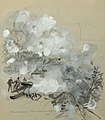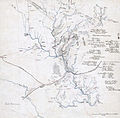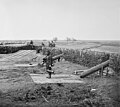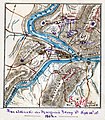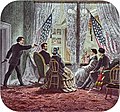Portal:American Civil War: Difference between revisions
m discontinued portal Tag: Disambiguation links added |
Michael7604 (talk | contribs) I don't think portals are supposed to appear in article categories Tags: Reverted Disambiguation links added |
||
| Line 81: | Line 81: | ||
[[Category:Military and war-related portals]] |
[[Category:Military and war-related portals]] |
||
[[Category:United States portals]] |
[[Category:United States portals]] |
||
[[Category:American Civil War|π]] |
|||
[[Category:Unredirected portals with existing subpages]] |
[[Category:Unredirected portals with existing subpages]] |
||
[[Category:History portals]] |
[[Category:History portals]] |
||
Revision as of 07:08, 17 April 2024
 |
 |

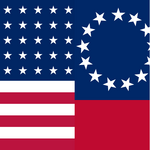
The American Civil War (1861–1865) was a sectional rebellion against the United States of America by the Confederate States, formed of eleven southern states' governments which moved to secede from the Union after the 1860 election of Abraham Lincoln as President of the United States. The Union's victory was eventually achieved by leveraging advantages in population, manufacturing and logistics and through a strategic naval blockade denying the Confederacy access to the world's markets.
In many ways, the conflict's central issues – the enslavement of African Americans, the role of constitutional federal government, and the rights of states – are still not completely resolved. Not surprisingly, the Confederate army's surrender at Appomattox on April 9,1865 did little to change many Americans' attitudes toward the potential powers of central government. The passage of the Thirteenth, Fourteenth and Fifteenth amendments to the Constitution in the years immediately following the war did not change the racial prejudice prevalent among Americans of the day; and the process of Reconstruction did not heal the deeply personal wounds inflicted by four brutal years of war and more than 970,000 casualties – 3 percent of the population, including approximately 560,000 deaths. As a result, controversies affected by the war's unresolved social, political, economic and racial tensions continue to shape contemporary American thought. The causes of the war, the reasons for the outcome, and even the name of the war itself are subjects of much discussion even today. (Full article)
The Sloan–Parker House, also known as the Stone House, Parker Family Residence, or Richard Sloan House, is a late-18th-century stone residence near Junction, Hampshire County, in the U.S. state of West Virginia. It was built on land vacated by the Shawnee after the Native American nation had been violently forced to move west to Kansas following their defeat at the Battle of Point Pleasant in 1774. The building was added to the National Register of Historic Places on June 5, 1975, becoming Hampshire County's first property to be listed on the register. The Sloan–Parker House has been in the Parker family since 1854. The house and its adjacent farm are located along the Northwestern Turnpike (US 50/WV 28) in the rural Mill Creek valley.
The original fieldstone section of the house was erected in about 1790 for Richard Sloan and his wife Charlotte Van Horn Sloan. Originally from Ireland, Sloan arrived in the United States after the American Revolutionary War and became an indentured servant of David Van Horn. Sloan eloped with Van Horn's daughter Charlotte and they settled in the Mill Creek valley, where they built the original stone portion of the house. The Sloans had ten children, including John and Thomas Sloan, who each (later) represented Hampshire County in the Virginia House of Delegates. Richard Sloan and his family operated a successful weaving business from the stone house and their Sloan counterpanes (woven coverlets with block designs) became well known in the South Branch Valley region. (Full article...)
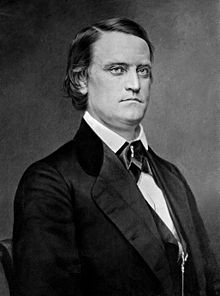
John Cabell Breckinridge (January 16, 1821 – May 17, 1875) was an American lawyer, politician, and soldier. He represented Kentucky in both houses of Congress and became the 14th and youngest-ever vice president of the United States. Serving from 1857 to 1861, he took office at the age of 36. He was a member of the Democratic Party, and ran for president in 1860 as a Southern Democrat. He served in the U.S. Senate during the outbreak of the American Civil War, but was expelled after joining the Confederate Army. He was appointed Confederate Secretary of War in 1865.
Breckinridge was born near Lexington, Kentucky, to a prominent local family. After serving as a noncombatant during the Mexican–American War, he was elected as a Democrat to the Kentucky House of Representatives in 1849, where he took a states' rights position against interference with slavery. Elected to the U.S. House of Representatives in 1851, he allied with Stephen A. Douglas in support of the Kansas–Nebraska Act. After reapportionment in 1854 made his re-election unlikely, he declined to run for another term. He was nominated for vice president at the 1856 Democratic National Convention to balance a ticket headed by James Buchanan. The Democrats won the election, but Breckinridge had little influence with Buchanan, and as presiding officer of the Senate, could not express his opinions in debates. He joined Buchanan in supporting the proslavery Lecompton Constitution for Kansas, which led to a split in the Democratic Party. In 1859, he was elected to succeed Senator John J. Crittenden at the end of Crittenden's term in 1861. (Full article...)
- ... that after the Little Rock campaign, Union forces held three-quarters of Arkansas?
- ... that according to one historian, James S. Rains made a "significant contribution to the Confederate war effort" by getting drunk?
- ... that Enoch Marvin Banks resigned from the University of Florida because of public outrage over his belief that the American Civil War was caused by slavery?
- ... that some historians believe that Steele's Greenville expedition marked a shift in the Union's war policy?
- ... that in the aftermath of the American Civil War, the only Black-led organization providing teachers to formerly enslaved people was the African Civilization Society?
- ... that at the Battle of La Haye-du-Puits in July 1944, a Confederate flag dating to the American Civil War was raised over the town?
- Attention needed
- ...to referencing and citation • ...to coverage and accuracy • ...to structure • ...to grammar • ...to supporting materials
- Popular pages
- Full list
- Cleanup needed
- The West Tennessee Raids
- Requested articles
- James Ashby (soldier) • Bluffton expedition • Benjamin D. Fearing • Charles A. Hickman • Richard Henry Jackson • James B. Speers • Charles S. Steedman • Battle of Barton's Station • Lawrence P. Graham • Thomas John Lucas • Daniel Henry Rucker • James Hughes Stokes • Frederick S. Sturmbaugh • Davis Tillson • Action at Nineveh (currently a redirect) • International response to the American Civil War • Spain and the American Civil War • Savannah Campaign Confederate order of battle • Native Americans in the American Civil War (currently disambiguation after deletion) • 1st Battalion, Mississippi Mounted Rifles (Union) • Battle of Lafayette • Requested American Civil War Medal of Honor recipients
- Expansion needed
- Battle of Boonsborough • Battle of Guard Hill • Battle of Rice's Station • Battle of Simmon's Bluff • Battle of Summit Point • Charleston Arsenal • Edenton Bell Battery • First Battle of Dalton • Blackshear Prison • Edwin Forbes • Hiram B. Granbury • Henry Thomas Harrison • Louis Hébert (colonel) • Benjamin G. Humphreys • Maynard Carbine • Hezekiah G. Spruill • Smith carbine • Edward C. Walthall • Confederate States Secretary of the Navy • Confederate States Secretary of the Treasury • David Henry Williams • Battle of Rome Cross Roads • Delaware in the American Civil War • Ironclad Board • United States Military Railroad • Kansas in the American Civil War • Rufus Daggett • Ebenezer Magoffin • Confederate Quartermaster-General's Department • First Corps, Army of Northern Virginia • Francis Laurens Vinton • Henry Maury • Smith's Expedition to Tupelo • Other American Civil War battle stubs • Other American Civil War stubs
- Images needed
- Battle of Lone Jack • Preston Pond, Jr. • Melancthon Smith
- Merging needed
- 1st Regiment New York Mounted Rifles and 7th Regiment New York Volunteer Cavalry
- Citations needed
- 1st Alabama Cavalry Regiment (Union) • 4th Maine Battery • 33rd Ohio Infantry • 110th New York Volunteer Infantry • Battle of Hatcher's Run • Camp Dennison • Confederate colonies • CSS Resolute • Dakota War of 1862 • Florida in the American Civil War • Ethan A. Hitchcock (general) • Fort Harker (Alabama) • Gettysburg (1993 film) • Iowa in the American Civil War • Second Battle of Fort Sumter • Samuel Benton
- Translation needed
- Add an article here!
The following Wikimedia Foundation sister projects provide more on this subject:
-
Commons
Free media repository -
Wikibooks
Free textbooks and manuals -
Wikidata
Free knowledge base -
Wikinews
Free-content news -
Wikiquote
Collection of quotations -
Wikisource
Free-content library -
Wikiversity
Free learning tools -
Wikivoyage
Free travel guide -
Wiktionary
Dictionary and thesaurus
- Shortcuts to this page: Portal:ACW • P:ACW






